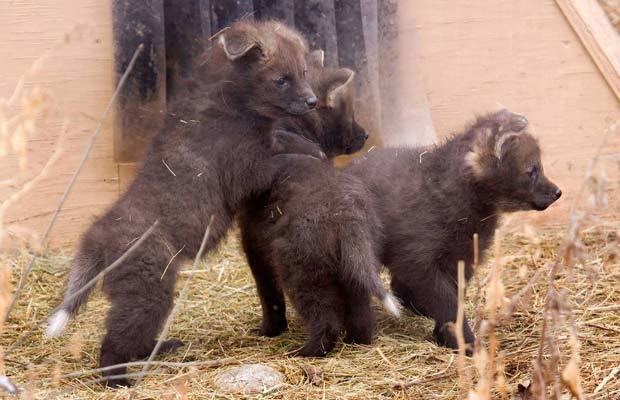The South American Maned Wolf is one of those animals you
look at and think that it looks familiar, but can’t quite place it. It has the
body shape and overall features of a fox, with long legs that resemble a deer.
Along with containing the name of a wolf, what exactly is this creature
mash-up?
The Maned Wolf is technically not a wolf, or a fox, but it is
a member of the canid family, which relates it to a wolf. A huge difference
between the Maned Wolf and other wolves is that they are solitary in nature,
meaning they will not typically travel in groups and prefer to be alone. Even
though these creatures typically care for themselves, a male and a female
typically share a home range and remain monogamous throughout their lives. Even
though they live in the same area, the male and female will only come together
during the mating season in which the female delivers up to 5 adorable pups
(picture below). The pups are cared for primarily by the female for about 2 and
a half months before becoming independent. After the pups grow to a year old,
they typically leave to find their own home range and mate.
Although these creatures look majestic, they have a side that
is not so glamorous as well. Each monogamous pair “owns” a territory that is
about 10square miles, so how do they defend this if they never see each other?
They pee and poop. That’s right, every night they make sure that they deposit
their extremely powerful urine and feces around the edge of their territory to
warn others to stay away. It has been said that this herbal smell is so strong
it is often compared to the smell of marijuana or a skunk. The smell is so
similar to cannabis that Netherlands police were once searching the Rotterdam
zoo for a pot-smoker, only to find out that it was the urine of the Maned Wolf.
These creatures can still be found in the wild near the
central part of South America, usually in the thick brush. The Maned Wolf is an
omnivore that has an extremely diverse diet consisting of small mammals, fish,
fruits, insects, and even road kill. There are no natural predators to the
Maned Wolf, however humans are the main source in their decline in population.
Since these animals require such a large home range, they often venture into
agricultural areas and onto highways. Even though there are preserves for these
animals, about half of the pups each year are killed on highways that border
these preserves. Another major reason for population decline is human sport.
There are some people in South America who believe that this animal holds
medicinal or magical purposes which leads to an increase in hunting. Who knows,
maybe the natives are onto something and this “fox-on-stilts” is magical after
all.
Sources and Picture References
http://www.wired.com/wiredscience/2011/03/maned-wolf-pee-demystified/
http://seancrane.com/2011/02/maned-wolf-2/
http://nationalzoo.si.edu/animals/amazonia/facts/manedwolves.pdf


No comments:
Post a Comment